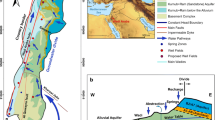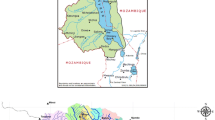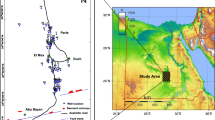Abstract
Sustainable yield is defined as the amount of groundwater abstraction that can be maintained for an indefinite time without causing unacceptable environmental, economic and social consequences. It is usually determined by monitoring the water-table depth, without the need for costly pumping exercises and subsequent deterioration of the groundwater and ecological environment. Groundwater numerical modelling provides an effective way to determine the yield by analysing the responding water levels to various pumping scenarios. In this study, the natural flow system and flow with pumping scenarios were simulated using FEFLOW for the fractured-rock aquifer in Table Mountain Group, South Africa. Results for different pumping rates show the distinct impact of groundwater abstraction on hydraulic head, which indicates that long-term abstraction slowly increases the well drawdown, but it would stabilize at a level that is dependent on pumping rate and induced recharge. To estimate the aquifer sustainable yield, a relationship between simulated drawdown and pumping rate was established, namely an exponential function with parameters that may change value between sites. This empirical relation, derived from this site-specific study, provides an option for informed decision-making. The issue of how to sustainably abstract groundwater might rely on a compromise between the groundwater user and the governmental authority.
Résumé
Le rendement durable est défini comme le volume d’eau souterraine extrait qui peut être maintenu pour une durée indéterminée sans engendrer de conséquences environnementale, économique et sociale inacceptables. Il est généralement déterminé par un suivi de la profondeur du niveau de la nappe phréatique, sans que des pompages coûteux soient nécessaires et sans détérioration ultérieurement de l’eau souterraine et de l’environnement écologique. La modélisation numérique des eaux souterraines fournit un moyen efficace de déterminer le rendement par l’analyse de la réponse des niveaux d’eau selon divers scénarios de pompage. Dans cette étude, le régime d’écoulement naturel du système et les écoulements avec scénarios de pompage ont été simulés avec FEFLOW pour l’aquifère fracturé de la formation Montagne de la Table en Afrique du Sud. Les résultats pour différents débits de pompage montrent un impact marqué du volume extrait des eaux souterraines sur la charge hydraulique, indiquant que l’exploitation à long terme augmente le rabattement au puits, mais celui-ci se stabiliserait à un niveau qui est fonction du débit de pompage et de la recharge induite. Afin d’estimer le rendement durable de l’aquifère, une relation entre le rabattement simulé et le débit pompé a été développée, à savoir une fonction exponentielle dont la valeur des paramètres peut changer entre les sites. Cette relation empirique, déduite à partir de cette étude spécifique de cas, fournit une option pour une prise de décision éclairée. La problématique du comment exploiter durablement une eau souterraine, pourrait reposer sur un compromis entre les utilisateurs des eaux souterraines et les instances gouvernementales.
Resumen
El rendimiento sostenible se define como la cantidad de extracción de agua subterránea que se puede mantener por un tiempo indefinido sin causar consecuencias ambientales, económicas y sociales inaceptables. Por lo general, se determina al monitorear la profundidad del nivel freático, sin la necesidad de costosos ejercicios de bombeo y el subsiguiente deterioro del agua subterránea y del entorno ecológico. El modelado numérico del agua subterránea proporciona una forma efectiva de determinar el rendimiento al analizar los niveles de agua que responden a diferentes escenarios de bombeo. En este estudio, el sistema de flujo natural y el flujo con escenarios de bombeo se simularon utilizando FEFLOW para el acuífero de roca fracturada en el Table Mountain Group, Sudáfrica. Los resultados para diferentes caudales de bombeo muestran el impacto particular de la extracción de agua subterránea en la carga hidráulica, lo que indica que la extracción a largo plazo aumenta lentamente la depresión en el pozo, pero se estabilizaría en un nivel que depende del caudal de bombeo y de la recarga inducida. Para estimar el rendimiento sostenible del acuífero, se estableció una relación entre la depresión simulada y el caudal de bombeo, es decir, una función exponencial con parámetros que pueden cambiar el valor entre los sitios. Esta relación empírica, derivada de este estudio específico del sitio, proporciona una opción para tomar decisiones fundadas. El tema de cómo extraer de manera sostenible el agua subterránea puede depender de un compromiso entre el usuario de agua subterránea y la autoridad gubernamental.
摘要
地下水可持续产量可定义为长期抽水而不会对环境,经济和社会造成不可接受后果的取水量。通常通过监测水位深度来确定,而不需要经历昂贵的抽水以及随后产生的地下水和生态环境的恶化。该方法通过分析各种抽水情行的水位响应,地下水数值模拟提供了一种确定该产量的有效方法。本项研究采用FEFLOW分别模拟了南非桌山群中一个裂隙含水层的自然流动和抽水情况下的地下水动态系统。结果显示不同抽水量对含水层水头的影响明显,长期抽水会缓慢增加井的降深,但该含水层的水位最终会稳定在一个深度,这决于单位抽水量和由此引发的地下水补给。同时通过数值模拟来估算含水层的可持续产量,建立了模拟降深和单位抽水量之间的联系,即二者为指数函数关系,其参数可随着含水层的条件变化而不同。这种来自本特定研究的经验关系为决策提供了一个选择,即如何可持续地抽取地下水的取决于地下水用户和水资源管理部门之间的协商结果。
Resumo
O rendimento sustentável é definido como a quantidade de captação de água subterrânea que pode ser mantida por um tempo indefinido sem causar consequências ambientais, econômicas e sociais inaceitáveis. Geralmente é determinado pelo monitoramento da profundidade do lençol freático, sem a necessidade de exercícios caros de bombeamento e subsequente deterioração do lençol freático e do ambiente ecológico. A modelagem numérica das águas subterrâneas fornece uma maneira eficaz de determinar o rendimento analisando as respostas dos níveis de água à vários cenários de bombeamento. Neste estudo, o sistema de fluxo natural e o fluxo com cenários de bombeamento foram simulados usando o FEFLOW para o aquífero de rocha fraturada no Grupo Table Mountain, na África do Sul. Os resultados para diferentes taxas de bombeamento mostram o impacto distinto da captação de águas subterrâneas na carga hidráulica, que indica que a captação de longo prazo aumenta lentamente o rebaixamento do poço, mas se estabiliza em um nível que depende da taxa de bombeamento e da recarga induzida. Para estimar o rendimento sustentável do aquífero, estabeleceu-se uma relação entre a redução simulada e a taxa de bombeamento, ou seja, uma função exponencial com parâmetros que podem alterar o valor entre os locais. Esta relação empírica, derivada deste estudo em local específico, fornece uma opção para tomada de decisão informada. A questão de como extrair água subterrânea de forma sustentável pode depender de um compromisso entre o usuário de águas subterrâneas e a autoridade governamental.












Similar content being viewed by others
References
Alley WM, Leake SA (2004) The journey from safe yield to sustainability. Ground Water 42(1):12–16
Alley WM, Reilly TE, Franke OE (1999) Sustainability of groundwater resources. US Geol Surv Circ 1186, 79 pp
Anderson MP, Woessner WW (2002) Applied groundwater modelling: simulation of flow and advective transport. Elsevier, Atlanta, GA
Baron J, Seward P, Seymour A (1998) The groundwater harvest potential map of the republic of South Africa. Technical report Gh 3917, Directorate Geohydrology, Dept. of Water Affairs and Forestry, Pretoria, South Africa
Berkowitz B (2002) Characterizing flow and transport in fractured geological media: a review. Adv Water Resour 25:861–884
Bredehoeft JD (1997) Safe yield and the water budget myth. Ground Water 35(6):929
Bredehoeft JD (2002) The water budget myth revisited: why hydrogeologists model. Ground Water 40(4):340–345
Bredehoeft JD, Papadopulos SS, Cooper HH Jr (1982) Groundwater: the water-budget myth. In: Scientific basis of water resource management. National Academy Press, Washington, DC, pp 51–57
Caine JS, Evans JP, Forster CB (996) Fault zone architecture and permeability structure. Geology 24:1025–1028
Chiang WH, Kinzelbach W (2001) 3D groundwater modeling with PWWIN. Springer, Berlin, 346 pp
Custodio E (2005) Intensive use of ground water and sustainability. Ground Water 43(3):291
De Beer CH (2002) The stratigraphy, lithology and structure of the Table Mountain Group. In: Petersen K, Parsons R (eds) A synthesis of the hydrogeology of the Table Mountain Group: formation of a research strategy. WRC report no. TT 158/01, Water Research Commission, Pretoria, South Africa, pp 9–18
Delvin JF, Sophocleous M (2005) The persistence of the water budget myth and its relationship to sustainability. Hydrogeol J 13(4):549–554
DHI-WASY GmbH (2009) Finite element subsurface flow & transport simulation system. White Papers 1:368
Diersch HG (2014) FEFLOW: finite element modeling of flow, mass and heat transport in porous and fractured media. Springer, Heidelberg, Germany, 996 pp
DWA (Department of Water Affairs) (2013) National water resources strategy, 2nd edn. 201 pp. Available online at www.dwa.gov.za/documents/Other/Strategic%20Plan/NWRS2-Final-email-version.pdf. Accessed November 2018
Gambolati G, Gatto P, Freeze RA (1974) Mathematical simulation of the subsidence of Venice: 2. results. Water Resour Res 10(3):563–577
Gudmundsson A, Geyer A (2006) Effects of damage-zone thickness on fault displacement. Poster on TSK 11 Göttingen, 2006
Holland M, Witthüser KT (2009) Factors that control sustainable yields in the Achaean basement rock aquifers of the Limpopo province. In: Titus RA, Adams S, Strachan L (eds) The basement aquifers of Southern Africa, WRC report no. TT 428/09, Water Research Commission, Pretoria, South Africa
Hunter J, Wilcox D (2003) Ecohydrology: why hydrologists should care. Ground Water 41(3):289
Jia H (2007) Groundwater resource evaluation in Table Mountain Group aquifer systems. PhD Thesis, University of the Western Cape, Cape Town, South Africa, 205 pp
Johri M (2012) Fault damage zones – observations, dynamic modeling, and implications on fluid flow. PhD thesis. Stanford University
Kalf F, Woolley D (2005) Applicability and methodology of determining sustainable yield in groundwater systems. Hydrogeol J 13(1):295–312
Lin L (2008) Hydraulic properties of the Table Mountain Group sandstone aquifer. PhD Thesis, University of the Western Cape, Cape Town, South Africa
Lin L, Xu Y (2006) A tensor approach to the estimation of hydraulic conductivities in Table Mountain Group aquifers of South Africa. Water SA 32(3):371–378
Lin L, Lin H, Xu Y, Ntuli T, Mahlangu F (2015) Impact of fault structures on the occurrence of groundwater in fractured rock aquifers, WRC report no. 2053/1/14, Water Research Commission, Pretoria, South Africa, 78 pp
Lohman SW (1972a) Ground-water hydraulics. US Geol Surv Prof Pap 708, 70 pp
Lohman SW (1972b) Definitions of selected ground water terms: revisions and conceptual refinements. US Geol Surv Water Suppl Pap 1988, 21 pp
Maimone M (2004) Defining and managing sustainable yield. Ground Water 6:809–814
Meinzer OE (1923) Outline of ground-water hydrology with definitions. US Geol Surv Water Suppl Pap 494
National Research Council (1996) Rock fractures and fluid flow: contemporary understanding and applications. National Academy Press, Washington, DC, 568 pp
Nel JM (2011) Implementation and benefit of groundwater source protection in fractured rock aquifers in South Africa. PhD dissertation. University of the Western Cape
Newton AR, Shone RW, Booth PWK (2006) The Cape Fold Belt. In: Johnson MR, Anhaeusser CR, Thomas RJ (eds) The geology of South Africa. Geological Society of South Africa, Pretoria, South Africa, pp 521–530
Ponce VM (2007) Sustainable yield of groundwater. Available online at http://groundwater.sdsu.edu/. Accessed November 2018
Seward P, Xu Y, Brendock L (2006) Sustainable groundwater use, the capture principle and adaptive management. Water SA 32(4):473–482
Shi X, Fang R, Wu J, Xu H, Sun Y, Yu J (2012) Sustainable development and utilization of groundwater resources considering land subsidence in Suzhou, China. Eng Geol 124:77–89
Shipton ZK, Cowie PA (2001) Damage zone and slip surface evolution over micron to km scales in high-porosity Navajo sandstone, Utah. J Struct Geol 23:1825–1844
Shipton ZK, Cowie PA (2003) A conceptual model for the origin of damage zone structures in a high-porosity sandstone. J Struct Geol 25:333–344
Sophocleous M, Devlin JF (2002) Discussion on the water budget myth revisited: why hydrogeologists model. Ground Water 40(4):340–345
Svensson U (2001) A continuum representation of fracture networks, part II: application to the Aspo Hard Rock Laboratory. J Hydrol 250:187–205
Sun X (2014) Testing and evaluation of artesian aquifers in Table Mountain Group aquifers. PhD Thesis, University of the Western Cape, Cape Town, South Africa, 178 pp
Theis CV (1940) The source of water derived from wells: essential factors controlling the response of an aquifer to development. Civil Eng 10:277–280
Trefry MG, Muffels C (2007) FEFLOW: a finite-element ground water flow and transport modeling tool. Ground Water 45(5):525–528
Van Heeswijk M, Smith DT (2002) Simulation of the ground water flow system at Naval Submarine Base Bangor and vicinity, Kitsap County, Washington. US Geol Surv Water Resour Invest Rep 02-4261, 142 pp
van Tonder GJ, Botha JF, Chiang WH, Kunstmann H, Xu Y (2001) Estimation of the sustainable yields of boreholes in fractured rock formations. J Hydrol 241:70–90
Vegter (1995) An explanation of a set of national groundwater maps. WRC report no. TT 74/95, Water Research Commission, Pretoria, South Africa
Wang M, Kulatilake PHSW, Panda BB, Rucker ML (2001) Groundwater resources case study via discrete fracture flow modelling. Eng Geol 62:267–291
Water Science and Technology Board (1990) Groundwater models: scientific and regulatory application. National Academy Press, Washington, DC
Xu Y, Colvin C, Van Tonder GJ, Hughes S, Le Maitre D, Zhang J, Braune E (2003) Towards the Resource Directed Measures: Groundwater Component. WRC report no. 1090-2/1/03. Water Research Commission, Pretoria, South Africa, 134 pp
Zhou Y (2009) A critical review of groundwater budget myth, safe yield and sustainability. J Hydrol 370:207–213
Acknowledgements
We are grateful to Prof. Y Xu from University of the Western Cape for his generous support in this research.
Funding
The author would like to acknowledge the Water Research Commission of South Africa who has funded this study.
Author information
Authors and Affiliations
Corresponding author
Rights and permissions
About this article
Cite this article
Lin, L., Lin, H. Determination of groundwater sustainable yield using a numerical modelling approach for the Table Mountain Group sandstone aquifer, Rawsonville, South Africa. Hydrogeol J 27, 841–855 (2019). https://doi.org/10.1007/s10040-018-1902-3
Received:
Accepted:
Published:
Issue Date:
DOI: https://doi.org/10.1007/s10040-018-1902-3




